
A beehive is an enclosed structure in which some honey bee species of the subgenus Apis live and raise their young. Though the word beehive is commonly used to describe the nest of any bee colony, scientific and professional literature distinguishes nest from hive. Nest is used to discuss colonies that house themselves in natural or artificial cavities or are hanging and exposed. Hive is used to describe an artificial/man-made structure to house a honey bee nest. Several species of Apis live in colonies, but for honey production the western honey bee and the eastern honey bee are the main species kept in hives.

A beekeeper is a person who keeps honey bees.

Beekeeping is the maintenance of bee colonies, commonly in man-made hives, by humans. Most such bees are honey bees in the genus Apis, but other honey-producing bees such as Melipona stingless bees are also kept. A beekeeper keeps bees in order to collect their honey and other products that the hive produce, to pollinate crops, or to produce bees for sale to other beekeepers. A location where bees are kept is called an apiary or "bee yard".
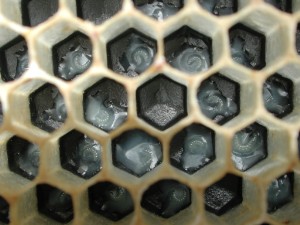
In beekeeping, bee brood or brood refers to the eggs, larvae and pupae of honeybees. The brood of Western honey bees develops within a bee hive. In man-made, removable frame hives, such as Langstroth hives, each frame which is mainly occupied by brood is called a brood frame. Brood frames usually have some pollen and nectar or honey in the upper corners of the frame. The rest of the brood frame cells may be empty or occupied by brood in various developmental stages. During the brood raising season, the bees may reuse the cells from which brood has emerged for additional brood or convert it to honey or pollen storage. Bees show remarkable flexibility in adapting cells to a use best suited for the hive's survival.
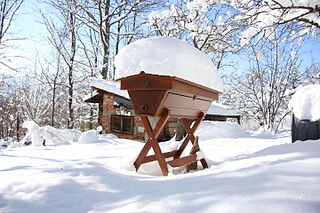
A top-bar hive is a single-story frameless beehive in which the comb hangs from removable bars. The bars form a continuous roof over the comb, whereas the frames in most current hives allow space for bees to move up or down between boxes. Hives that have frames or that use honey chambers in summer but which use management principles similar to those of regular top-bar hives are sometimes also referred to as top-bar hives. Top-bar hives are rectangular in shape and are typically more than twice as wide as multi-story framed hives commonly found in English speaking countries. Top-bar hives usually include one box only, and allow for beekeeping methods that interfere very little with the colony. While conventional advice often recommends inspecting each colony each week during the warmer months, heavy work when full supers have to be lifted, some beekeepers fully inspect top-bar hives only once a year, and only one comb needs to be lifted at a time.
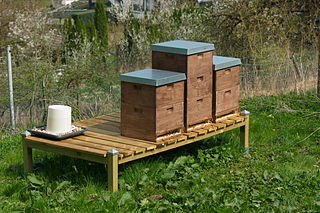
In modern American beekeeping, a Langstroth hive is any vertically modular beehive that has the key features of vertically hung frames, a bottom board with entrance for the bees, boxes containing frames for brood and honey and an inner cover and top cap to provide weather protection. In a Langstroth hive, the bees build honeycomb into frames, which can be moved with ease. The frames are designed to prevent bees from attaching honeycombs where they would either connect adjacent frames, or connect frames to the walls of the hive. The movable frames allow the beekeeper to manage the bees in a way which was formerly impossible.

The Caucasian honey bee is a subspecies of the western honey bee.

Comb honey is honey intended for consumption by humans, which is still contained within its original hexagonal-shaped beeswax cells, called honeycomb. It has received no processing, filtering, or manipulation, and is in the state that honey bees have produced it.

A hive frame or honey frame is a structural element in a beehive that holds the honeycomb or brood comb within the hive enclosure or box. The hive frame is a key part of the modern movable-comb hive. It can be removed in order to inspect the bees for disease or to extract the excess honey.

A honey extractor is a mechanical device used in the extraction of honey from honeycombs. A honey extractor extracts the honey from the honey comb without destroying the comb. Extractors work by centrifugal force. A drum or container holds a frame basket which spins, flinging the honey out. With this method the wax comb stays intact within the frame and can be reused by the bees.
Hive management in beekeeping refers to intervention techniques that a beekeeper may perform to ensure hive survival and to maximize hive production. Hive management techniques vary widely depending on the objectives.
This page is a glossary of beekeeping.
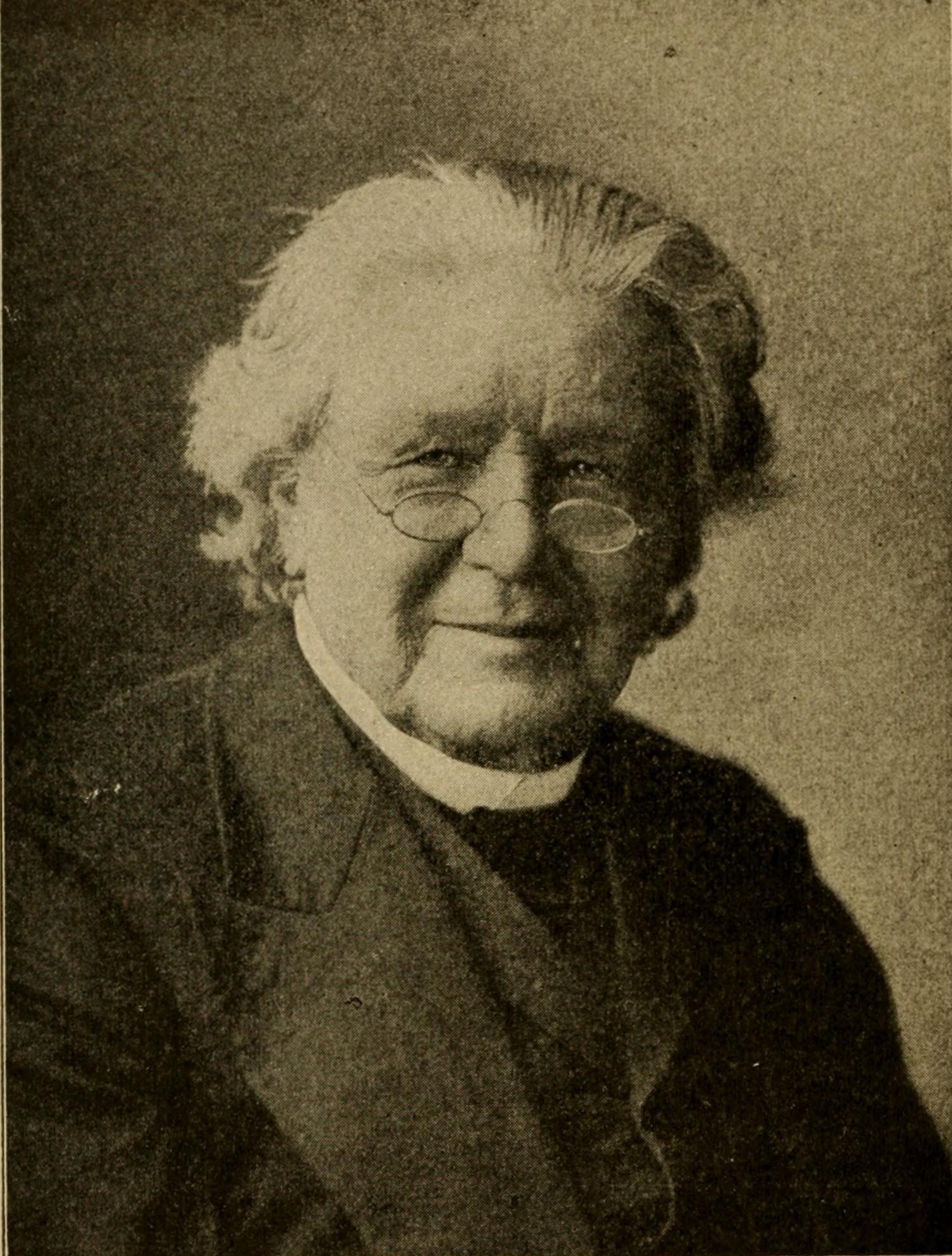
Rev. Lorenzo Lorraine Langstroth was an American apiarist, clergyman, and teacher, and considered to be the father of American beekeeping. He created the modern day Langstroth hive.

Petro Prokopovych was a revolutionary Ukrainian beekeeper, the founder of commercial beekeeping and the inventor of the first movable frame hive. He introduced novelties in traditional beekeeping that allowed great progress in the practice. Among his most important inventions was a hive frame in a separate honey chamber of his beehive. He also invented a crude queen excluder between brood and honey chambers. Petro Prokopovych was also the first to ever model a 'bee beard' after delineating and calculating 'bee swarm behaviour", inspiring students for generations.

Charles Dadant was a French-American beekeeper. Along with Petro Prokopovych, Dadant is considered one of the founding fathers of modern beekeeping.
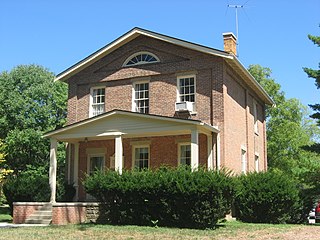
Langstroth Cottage is a historic building on the Western College campus of Miami University in Oxford, Ohio. It was designated a National Historic Landmark on June 22, 1976. The cottage, built in 1856, is now the home for the Oxford office of the Butler County Regional Transit Authority. It was purchased for Beekeeper L. L. Langstroth in 1859, and he lived there for the next 28 years, conducting research and breeding honey bees.

Honey extraction is the central process in beekeeping of removing honey from honeycomb so that it is isolated in a pure liquid form.
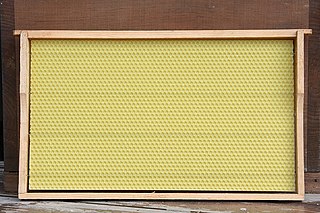
Wax foundation or honeycomb base is a plate made of wax forming the base of one honeycomb. It is used in beekeeping to give the bees a foundation on which they can build the honeycomb. Wax foundation is considered one of the most important inventions in modern beekeeping.

Flow Hive is a beehive designed to allow honey to be extracted simply by turning a knob: the hive does not have to be opened and the bees are not disturbed as in normal extraction.

Franz Hruschka also known as Franz von Hruschka or Francesco De Hruschka or František Hruška was an Austrian/Italian officer and beekeeper known as the inventor of the honey extractor, an invention he presented in 1865 at the Brno Beekeeper Conference.




















